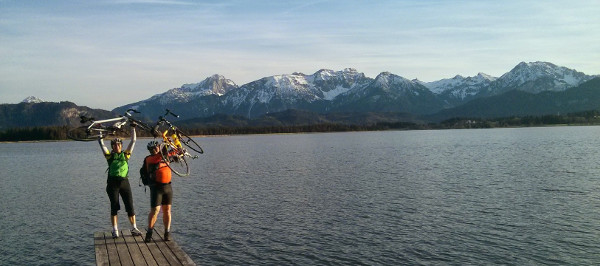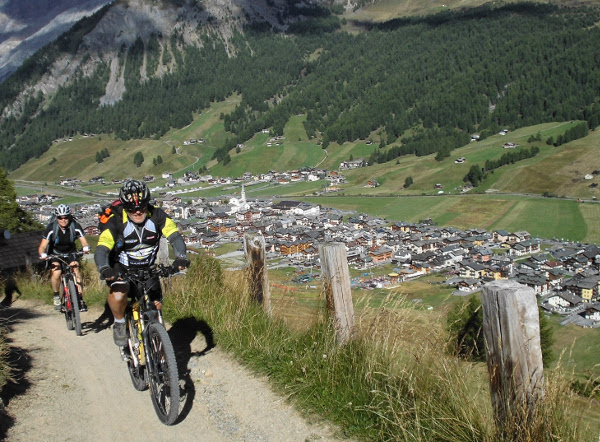
Elsewhere I mentioned that an important factor in achieving your adventure is to make and then keep to your training plan. This applies equally to training new skills or to your physical training.
I enjoy cycling (mountain bike and road bike) and the last few years we have been doing a week long road bike trip each Spring. Obviously it is vital to have a route planned but, with routes of a thousand kilometers, it is your fitness program that decides between success and failure.
Since the beginning of 2014 I have been using a Polar FT60 training computer to plan and monitor my training. This article describes my experience.
Originally I trained from Spring to Autumn and then went in to semi-hibernation with a bit of skiing and 2 hours light sport a week. The result was some amazing bike rides in Autumn when I felt I could take on the world and then the feeling of being back at zero the following Spring.

I decided to break this cycle by registering for indoor cycling in a fitness studio during the winter. For two years I exercised three or four times a week. I gave everything during the training sessions from beginning to end. I felt I was really achieving something and then – in Spring – I realised that it had not really helped.
The third winter I attended a different fitness studio. They began by asking what my aims were and so I explained about using the winter to prepare for cycling to be out enjoying myself as soon as the snow melted. Immediately the advantages of a training computer were explained to me. The trainer also explained that sitting on a training bike and pedalling continuously as fast and as hard as you can is not the way to get fitter. You need a plan and you need to be able to monitor your training and your progress. He couldn’t convince me to buy a training computer so he leant me one for six weeks convinced I would buy it at the end. He was absolutely correct.
The FT60 looks like a watch and can even tell you the time and date. It comes with a breast strap and sender and together the three components can monitor your heartbeat.
To begin with the FT60 needs to know all about you – weight, size, age, sex, maximum heartbeat and how much time you have available for sport. It then asks you to lie down and relax and measures how fit you are. I have no idea how it does this but the results agree with my own estimations. I carried out the first measurement in the middle of winter after a few months of “hibernation” and the result was an OwnIndex (VO2max) of 35 which Polar writes is “average” for my age.

The FT60 next wants to know what your aim is – lose weight or get fitter. I chose the latter and it then created a training program in which it gave me weekly target times that I should spend in each heartbeat zone.
Before each training session the FT60 wants you to check your OwnZone by doing a warm up. It uses this warm up phase to decide the optimal training zones for that moment. How this is done is described in a paper by Eric Kappes; the paper is however in German but a summary of the system in English is here. After the test you receive three heartbeat zones to train in. This system seems to work very well. If I have had a hard day, the values will be lower; if it was easier they will be higher. After two years I can make a good guess at what the FT60 is going to predict.

What amazed me was that the FT60 was suggesting levels of exercise well below those I had been achieving until now. To begin with I was hardly sweating. My trainers insisted that this is normal and that my problem was that, to date, I had been training ineffeciently. I have since seen the same effect with others who start training with the device. Over the weeks and months the targets got harder and it became increasingly difficult to reach the third zone.
I kept to the zones and training times suggested and each week I was rewarded with a little picture of a trophy which remains on the screen for a week so that you and all your fellow trainees can see how well you are doing. This sounds really “childlish” but I found it motivating.
After six weeks I repeated the fitness test. This time my OwnIndex was 43. Another six weeks later it has risen to 50. Polar writes that this was an improvement from “average” to “excellent”. I felt the change over the three months and at the end of the fourth month cycled over 800 kilometers to Poland in six easy days. During the three months I lost 14% of my body weight and because of the calculation used for OwnZone, this would have automatically led to an equivalent improvement in the value without any “real” change. My results however improved by 42%.

The following year I once again used the FT60 to control my fitness training and at the beginning of the summer easily managed the 1000 kilometers to Rome.
Two years later I am still using the FT60 for cycling and indoor cycling and my OwnIndex is still between 48 & 50 even though I have put some of the lost weight back on.
To summarize, I am very impressed with my FT60 and with the entire concept behind a training computer. I was convinced I didn’t need it but have been proved wrong. It is easy to use and effective. Polar no longer sell the FT60 but I am sure most of what I have written would apply to any other of their training computers.


One thought on “Experience with a Polar Training Computer”